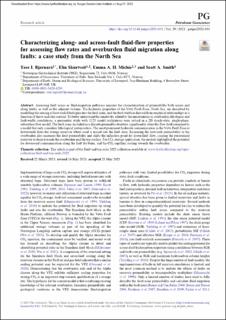Characterizing along- and across-fault fluid-flow properties for assessing flow rates and overburden fluid migration along faults: a case study from the North Sea
Peer reviewed, Journal article
Published version
Permanent lenke
https://hdl.handle.net/11250/3083133Utgivelsesdato
2023Metadata
Vis full innførselSamlinger
- NGI articles [1026]
Originalversjon
10.1144/petgeo2023-033Sammendrag
Assessing fault zones as fluid-migration pathways requires the characterization of permeability both across and along faults, as well as the adjacent volume. The hydraulic properties of the Vette Fault Zone, North Sea, are described by modelling the mixing of host-rock lithologies into the fault zone, and the fault width is derived from empirical relationships as a function of throw and clay content. To better understand the sensitivity related to the uncertainties in overburden lithologies and fault-width correlations, a parametric study with 1125 model realizations were solved in a 2D steady-state, single-phase, subsurface flow model. The fault zone, included as a discrete permeable structure, significantly alters the flow field compared to a model that only considers lithological juxtaposition. The most prominent hydraulic communication in the Vette Fault Zone is downwards from the storage reservoir where sand is mixed into the fault zone. Increasing the host-rock permeability in the overburden also increases the fault permeability and shifts the inflection point for down-fault flow, causing the pressurized reservoir to drain towards the overburden and the top surface. For CO2 storage application, the models highlighted the potential for downward communication along the fault for brine, and the CO2 capillary sealing towards the overburden. Characterizing along- and across-fault fluid-flow properties for assessing flow rates and overburden fluid migration along faults: a case study from the North Sea
